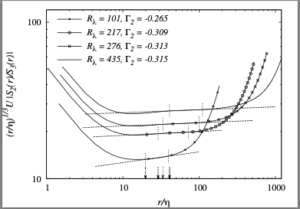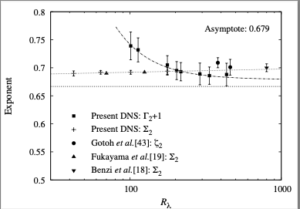The importance of terminology: stationarity or equilibrium?
The importance of terminology: stationarity or equilibrium?
When I began my post-graduate research in 1966, I found that I immediately had to get used to a new terminology. For instance, concepts like homogeneity and isotropy were a definite novelty. In physics one takes these for granted and they are never mentioned. Indeed the opposite is the case, and the occasional instance of inhomogeneity is encountered: I recall that one experiment relied on an inhomogeneity in the magnetic field. Also, in relativity one learns that a light source can only be isotropic in its co-moving frame. In any other frame, in motion relative to it, the source must appear anisotropic, as shown by Lorentz transformation. For the purposes of turbulence theory (and the theory of soft matter), exactly the same consideration must apply to Galilean transformation. Although, to be realistic, Galilean transformations are actually of little value in these fields, as they are normally satisfied trivially [1].
Then there was the transition from statistical physics to, more generally, the subject of statistics. The Maxwell-Boltzmann distribution was replaced by the normal or Gaussian distribution; and, in the case of turbulence, there was the additional complication of a non-Gaussian distribution, with flatness and skewness factors looming large. (I should mention as an aside that the above does not apply to quantum field theory which is pretty much entirely based on the Gaussian distribution.)
Perhaps the most surprising change was from the concept of equilibrium to one of stationarity. In physics, equilibrium means thermal equilibrium. Of course, other examples of equilibrium are sometimes referred to as special cases. For instance, a body may be in equilibrium under forces. But such references are always in context; and the term equilibrium, when used without qualification of this kind, always means thermal equilibrium. So any real fluid flow is a non-equilibrium process, and turbulence is usually classed as far from equilibrium. Indeed, physicists normally seem to regard turbulence as being the archetypal non-equilibrium process.
Unsurprisingly, the term has only rarely been used in turbulence. I can think of references to the approximate balance between production and dissipation near the wall in pipe flow being referred to as equilibrium; but, apart from that, all that comes to mind is Batchelor’s use of the term in connection with the Kolmogorov (1941) theory [2]. This was never widely used by theorists but recently there has been some usage of the term, so I think that it is worth taking a look at what it is; and, more importantly, what it is not.
Batchelor was carrying on the idea of Taylor, that describing homogeneous turbulence in the Fourier representation allowed the topic to be regarded as a part of statistical physics. He argued that the concept of local stationarity that Kolmogorov had introduced could be regarded as local equilibrium, in analogy with thermal equilibrium. The key word here is ‘local’. If we consider a flow that is globally stationary (as nowadays we can, because we have computer simulations), then clearly it would be nonsensical to describe such a flow as being in equilibrium.
However, recently Batchelor’s concept of local equilibrium has been mis-interpreted as being the same as the condition for the existence of an inertial range of wavenumbers, where the flux through wavenumber becomes equal to the dissipation rate. It is important to understand that this concept is not a part of Kolmogorov’s $x$-space theory but is part of the Obukhov-Onsager $k$-space theory. In contrast, the concept of local stationarity can be applied to either picture; but in my view is best avoided altogether.
I will say no more about this topic here, as I intend to develop it over the next few weeks. In particular, I think it would be helpful to make a pointwise summary of Kolmogorov-Obukhov theory, emphasising the differences between $x$-space and $k$-space forms, clarifying the historical position and indicating some significant and more recent developments.
[1] W. D. McComb. Galilean invariance and vertex renormalization. Phys. Rev. E, 71:37301, 2005.
[2] G. K. Batchelor. The theory of homogeneous turbulence. Cambridge University Press, Cambridge, 2nd edition, 1971.

